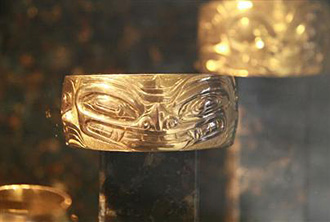
|
 |
 |
 Vallarta Living | Art Talk | June 2008 Vallarta Living | Art Talk | June 2008  
The Fine Art of the Heist
 Noah Charney - National Post Noah Charney - National Post
go to original


| | A photo of one of the Bill Reid pieces stolen from UBC's Museum of Anthropology. (Terry Ko/Canwest News Service) | | |
The recent theft of Mexican jewellery and sculptures created by Canadian artist Bill Reid from the University of British Columbia Museum may prove that crime does pay.

The theft was clearly planned and executed by professional criminals, likely with ties to organized crime. The timing of the theft, during the brief period when the one guard on duty went for a cigarette break, shows either patient planning or inside information. The premises likely had been surveyed for some time, to track security staff patterns.

The thieves had significant knowledge of electronic security systems: They appear to have disabled the recording mechanisms of the surveillance cameras while the cameras were still on. They wore gas masks and doused the entrance with bear spray, which would have immobilized security or police seeking to intervene (though none did). The stolen objects were found immediately, with no rummaging. Of particular interest was the retrieval of Mexican jewellery that was not in an open display. The criminals knew exactly what they were looking for.

What will become of the stolen objects?

Bill Reid is a Canadian icon, but there is a limited international market for his work. His sculptures are also easily identifiable, which makes sales abroad difficult.

The least likely scenario in this - and all art thefts - is a theft commissioned by a collector. There have been almost no proven cases of proactive criminal collection outside of war in history. This theft was almost certainly commissioned, but by a criminal administrator, most likely a member of an organized crime syndicate, with a business plan for profiting from the theft. Since the 1960s, in fact, nearly ever art crime has been perpetrated by, or on behalf of, organized crime syndicates.

Criminals often learn the value of stolen art only from subsequent media reports. In this case, the works were valued at $2-million. There is a strong possibility that the museum or its insurers will be quietly offered the

objects for a ransom that would approach this sum. If ransom fails, the works will likely be melted down for their gold content. This benefits the thieves in two ways: First, it serves to eradicate the evidence; and second, the metal can be sold for a profit.

The best chance at recovering the objects and preventing their destruction is to do just what the museum has done: offer a cash reward that is of greater value than the raw gold would fetch. In the case of Reid's work, given his status as an artist, this is an understandable move. But in general, the payment of a reward or ransom to criminals encourages future crimes. (For this reason, it is illegal in many countries to negotiate with ransomers at all.)

The museum and its insurers have two options: Pay to recover the objects, and thereby enrich the criminals who robbed from them; or refuse to negotiate and lose these treasured works forever.

Neither outcome is particularly palatable.

Noah Charney is the author of The Art Thief (Simon & Schuster) and founding director of ARCA, The Association for Research into Crimes against Art.
Police See 'Strong Possibility' That Bill Reid's Gold May Still be in Lower Mainland
Canwest News Service
go to original

Police believe there is a "strong possibility" that the 12 pieces stolen from a Bill Reid native art exhibit in Vancouver late last month are still in the Lower Mainland of British Columbia, with thieves from the region possibly trying to sell the artifacts through a Vancouver-area network of criminal associates. Constable Annie Linteau of the B. C. RCMP also said police are still seeking an "anonymous tipster" who has contacted them in the past and may have additional information useful to the case.

On May 24, the University of British Columbia's Museum of Anthropology discovered the disappearance of the renowned art, worth an estimated $2-million. Eleven of the 12 stolen pieces, including the one shown at right, were crafted from gold and, with its current high price, experts fear the thieves may have wanted to melt down the artifacts for their precious metal content. | 
 | |
 |



